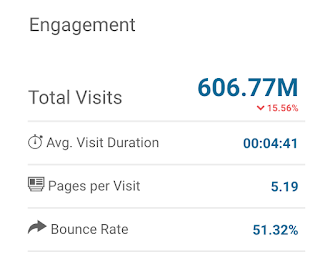Bounce Rate
Bounce Rate
Bounce Rate can be one of the important (and frustrating) things for marketers to consider when conducting an SEO analysis. So, what is a bounce rate? Your website’s bounce rate is the number of people who visit your website and leave without clicking any other links. If you have a high bounce rate, this means people are leaving without converting, which would indicate that your website is not “sticky” (What is a Bounce Rate, n.d.). If the goal of your website is to encourage visitors to browse in order to convert, a high bounce rate could indicate issues with your website.
A high bounce rate could indicate any number of issues. It could be related to broken links being present, or it could be a flaw in the design of the site. Maybe the site is cluttered and needs to be streamlined. Or, in some cases, the bounce rate matters very little because the site is designed for a visitor to not navigate (Patel, 2020). At any rate, this is one of the factors that Google Analytics considers when analyzing a site, and the results can help marketers determine what changes they can make to their website. Google Analytics will determine the bounce rate for the entirety of your website, and also for individual pages on your website, allowing you to make changes to pages that are performing worse than others (17 Proven Tactics, 2020).
A bounce rate should be in the 26-40% range to be considered excellent, with 41-55% considered average (O’Reilly, 2017). Through Google Analytics, you can determine what web browsers your visitors are using, and this can help you find a correlation between bounce rate and problems your site may be running into on a specific browser (12 Web Design Changes, 2012) or from mobile devices.
To improve your website’s bounce rate, it may be as simple as changing your site’s layout. For blog posts, this could include adding headings, photos, charts, and graphs to the page to increase engagement (Patel, 2020). According to SEMrush, bounce rates can be affected by slow page speeds, pop-ups, poor usability, or low-quality content (Lahey, 2020).
I do not personally shop at Walmart.com because I feel that their website is difficult to navigate, and I prefer Target’s user experience. So, I was curious to see where Walmart’s bounce rate sits. Walmart’s bounce rate is currently 51%, falling within the realm of “average” for websites. As such a huge powerhouse with so many products, I feel that Walmart should look into the reason why they don’t have an excellent bounce rate to improve the shopping experience for their customers (Walmart.com Traffic Statistics, n.d.). This is even more important during the current pandemic and more people than ever are completing their shopping online.
I believe that website design is the most important change that marketers can make when attempting to lower bounce rates. Utilizing landing pages for campaigns can also help marketers to decrease bounce rate by streamlining the product offerings that are being presented to the visitor.
References:
12 Ways Web Designers Can Improve Website Bounce Rates. (2018, July 25). Retrieved February 01, 2021, from https://www.crazyegg.com/blog/improve-website-bounce-rates/
17 Proven Tactics to Reduce Your Bounce Rate and Increase Conversions. (2020, November 18). Retrieved February 01, 2021, from https://stablewp.com/how-to-reduce-bounce-rate/
Lahey, C. (2020, December 14). What Is Bounce Rate and What Is a Good Rate? Retrieved February 01, 2021, from https://www.semrush.com/blog/bounce-rate/
Patel, N. (2020, December 09). How to Increase Conversions by Analyzing Bounce Rate Analytics. Retrieved February 01, 2021, from https://neilpatel.com/blog/bounce-rate-analytics/
Walmart.com Traffic Statistics. (n.d.). Retrieved February 01, 2021, from https://www.similarweb.com/website/walmart.com/#overview
What is Bounce Rate? How to Measure, Interpret, and Improve It - Mailchimp. (n.d.). Retrieved February 01, 2021, from https://mailchimp.com/marketing-glossary/bounce-rate/

Hey Chelsea - Thanks for your post! You talked about how to lower a high a bounce rate so that visitors stay on a website longer. But what if a bounce rate is too low? As Ali (2016) explains, if Google Analytics tracking loads twice on one page, this means multiple page views are being tracked for a single page. Too low of a bounce rate typically signals a technical issue, and often happens when something is changed around with the code on a website (Ali, 2016).
ReplyDeleteAli, A. (2016, November 26). Troubleshooting Too Low Bounce Rate in GA. Retrieved from: https://optimizationup.com/troubleshooting-low-bounce-rate/
Chelsea, excellent post about the significance and basics of bounce rate! It's such a telling metric, and I think that's why it's so incredibly important for businesses to monitor. I think this anonymous commenter also makes a great point, as I hadn't even thought about what it could mean if bounce rate is too low. I think that's worth looking into a little more!
DeleteHollie
Great post! I like how you mention that the bounce rate depends upon what you want your target audience to do on the page.
ReplyDelete"...in some cases, the bounce rate matters very little because the site is designed for a visitor to not navigate (Patel, 2020)." This statement is very applicable to my current campaign pages in that I want the target audience to land on my page, complete the info form and bounce! So bounce rates are not a huge metric that I taken into account for certain aspects of my advertising plans.